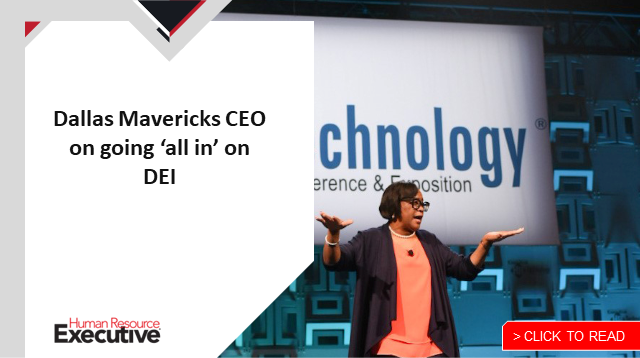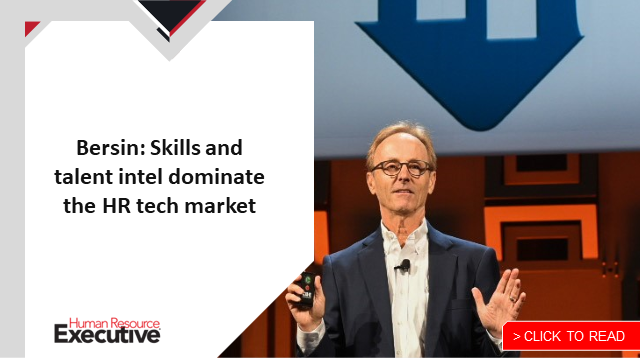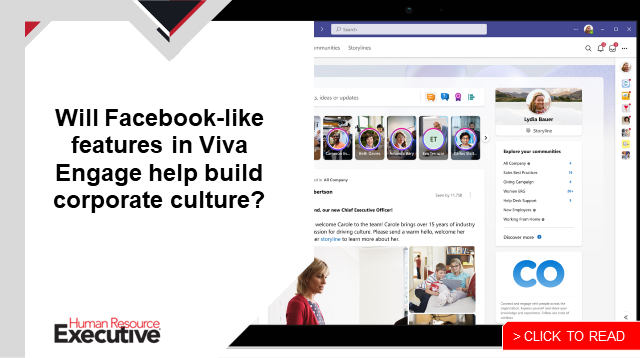There was no end to the discussions about HR’s challenges and ideas for solving them at this year’s HR Technology Conference, which took place earlier this month and featured content from hundreds of thought leaders and the biggest expo hall in conference history. Here are five takeaways from what we heard in briefings with vendors, general sessions, chats with experts and attendees, and on the expo floor to keep in mind as you start looking to 2023.
While popular, skills development needs clarity and oversight.
“I fear you have been oversold on the promise of skills. This is a very, very complex problem,” said Josh Bersin in his keynote address.
While employers view skills as a key to retaining employees and developing their careers inside the organization, the pursuit of skills development technology has led to a crowded and confusing layer of technology within enterprises. Bersin noted that HR and the IT leaders who serve them must deal with skills taxonomies, skills assessments (to record and list the skills already in existence within their workforce), skills needed for specific job roles and responsibilities, skills that are used in the labor market and more.
The proliferation of skills development and assessment tools has led to new job titles within the organization and overlap in job roles and responsibilities, said Bersin.
He presented a framework for considering skills technology vendors by showing the three layers of a skills architecture inside an organization. The Skills Tech Applications layer includes LinkedIn, Cornerstone, Phenom, iCIMS and more. The Skills Tech Pools and Middleware layer includes Microsoft, Empath, Degreed, Edcast and others. And finally, the Talent Intelligence Platforms layer includes Eightfold, Retrain and SkyHive.
Despite the crowded space, learning and development tech vendors see an eager market. “Since the pandemic,” said Dani Johnson, co-founder and principal analyst of Redthreat Research, “the skills conversation has blown up.”
Talent acquisition tech helps recruitment challenges.
When looking at the current job market, recruiters face a myriad of challenges: a declining population rate with Baby Boomers leaving the workforce every day, Gen Z-ers putting off marriage, the Great Resignation, quiet quitting and more.
“This will have a tremendous impact on recruiters in the future,” Bersin said.
Recruiters are also facing burnout as their mission to fill open job roles never appears to be complete. But dozens and dozens of vendors demonstrated AI-powered tools to ease those burdens and address the challenges of filling open roles. These tools include ones that plan and execute advertisement campaigns on major job sites such as LinkedIn and Indeed, people analytics tools that aim to find the right candidates with the skills and experience to fit the open role, and onboarding apps to help once the candidate is hired.
 And it’s not just white-collar roles that are being filled using these tools. Hourly service jobs have been difficult to fill since the outbreak of the pandemic and workers for these roles remain in high demand, said Joe Fantone, director of sales of PandoLogic. This solution helps recruiters create job postings and manage job advertising budgets. The vendor counts Amazon and Verizon as customers.
And it’s not just white-collar roles that are being filled using these tools. Hourly service jobs have been difficult to fill since the outbreak of the pandemic and workers for these roles remain in high demand, said Joe Fantone, director of sales of PandoLogic. This solution helps recruiters create job postings and manage job advertising budgets. The vendor counts Amazon and Verizon as customers.
“I have been coming to HR Tech for 10 years and we have been having these conversations for the past six years,” he said. “Retail and service are very competitive and in 2022, nearly everyone is having trouble reaching their hiring goals.”
Even the most American of companies, McDonald’s, has turned to AI to keep its burgers and fries flowing. In 2019, it partnered with Paradox to roll out McHire, the chain’s AI-enabled hiring platform. So far, the fast food giant has shortened application and scheduling time from three days to three minutes while doubling applications, with a 99+% candidate satisfaction rate, and reducing time-to-hire by 60%.
“It helps us hire faster, but what we’re getting out of that is offering a more personalized experience and engaging candidates between steps, especially now when the employee experience is at its most critical,” said Alexa Morse, director of HR operations and execution at McDonald’s.
HR wants more from HR tech vendors.
While HR leaders are awash in sophisticated-seeming solutions that aim to solve their problems, they report frustration with their tools’ ability to generate reports, a lack of support from vendors, and paying for extra features after a solution is implemented. The goodwill that existed between the HR leaders who bought and implemented the technology and the vendors who supported them and claimed to be partners has evaporated.
“The year of grace for HR technology providers is over,” warned Stacey Harris, chief research officer for market research firm Sapient Insights, in her keynote address.
Nearly all small, medium and large organizations report continuing struggles when managing their technology, she said.
And many of these HR tools often go unused by the employees whom HR leaders thought would benefit from these solutions. Unused or underused HR technology, which Bersin compared to a kitchen junk drawer, along with the nearly 50% of HR tech implementations that fail after two years, according to Microsoft’s Sunita Khatri, should spur HR leaders to rethink the technology that they use and deploy, Harris said.
“When looking at HR systems, it’s not a standalone system but an entire ecosystem,” she said. “As we share data, think about your role in the organization. How do you get people excited about new solutions?”
Vendor investment is slowing down, fueling consolidation.
A walk through the event’s bustling Expo Hall made one thing clear: Vendors see plenty of opportunity in the HR tech space and new companies are cropping up each year. But sweeping consolidation is taking place and will continue in the coming months.
“Every major software company wants in on HR,” said Bersin. Large-scale software and services firms including Microsoft, ADP, Workday, IBM, Facebook, Glassdoor, Oracle and SAP Successfactors and more are signing major clients and acquiring smaller companies for their technology and clients in small to medium-sized markets. Google also is making a big play in HR and deserves attention, according to Bersin.
 And start-ups continue to emerge. This year’s Pitchfest competition attracted 33 vendor companies that delivered three-minute presentations of their solutions in hopes of taking home a $25,000 grand prize from sponsor Randstad. This year’s winner, SPOTLYFE, won with a novel take on work-life balance and employee experience. “Think of us like a check engine light in your car to help you prevent burnout in your life,” said Josh Schwede, co-founder and CEO of the winning start-up.
And start-ups continue to emerge. This year’s Pitchfest competition attracted 33 vendor companies that delivered three-minute presentations of their solutions in hopes of taking home a $25,000 grand prize from sponsor Randstad. This year’s winner, SPOTLYFE, won with a novel take on work-life balance and employee experience. “Think of us like a check engine light in your car to help you prevent burnout in your life,” said Josh Schwede, co-founder and CEO of the winning start-up.
But this vibrant market is likely to see some slowing down in investment from private equity and VC firms. “The heavy investment days have come to an end and things will slow down from here,” said Bersin. Global VC funding has fallen 23% quarter over quarter to $108 billion this year, which the analyst calls the largest quarterly percentage drop in a decade.
Larger companies have gone on buying sprees in the past year in employee experience, talent acquisition and the skills and learning and development space, and Bersin expects more in the coming two years.
L&D, in particular, appears to be ripe for M&A activity, which means that HR leaders may have fewer choices for their tech vendor companies, but the companies they choose should have solutions to solve their challenges. This will be helpful as some HR leaders have to accomplish more with less, according to RedThread’s Johnson.
“Although there is still $675 million being invested in the learning tech space, smaller and newer employers are seeing some budget cuts for learning and upskilling in anticipation of possible layoffs,” she said.
People analytics drives EX.
 As HR leaders continue to focus on employee experience, especially in light of the Great Resignation, quiet quitting and the return-to-office debate, they must become experts in data analytics, advised officials from leading employee data firms like Visier, ADP and Phenom.
As HR leaders continue to focus on employee experience, especially in light of the Great Resignation, quiet quitting and the return-to-office debate, they must become experts in data analytics, advised officials from leading employee data firms like Visier, ADP and Phenom.
“HR leaders need to know about data, where to find it and how to process it,” said Ian Cook, vice president of research for Visier.
This data can be found in a variety of tools and processes within HR’s purview—from recruiting to onboarding to employee monitoring to performance review. Employee listening remains a key HR function and source of data as well.
“You cannot learn about your company unless you listen to employees. Employee listening is a massive space and is expanding,” said Bersin, who cited such vendors as ServiceNow, UKG, Monday.com, Asana, HubSpot and others that are delivering solutions that address employee listening, which can help overall employee experience.
Last week, Oracle announced Oracle Touchpoints, an employee listening solution that operates inside its Oracle ME employee experience platform. The new tool allows managers to continuously capture, track and act on employee sentiment.
The challenge of improving EX remains in finding, gathering and processing the right people data, which resides in multiple and often standalone platforms and solutions that were never designed to operate with and share data with other systems. Vendors such as Oracle, SAP, ADP and Microsoft and others are working to break down the data barriers so that HR leaders can generate reports and implement new practices that help retain valuable employees.
 HR leaders will need to look at multiple sources of data that were previously unexamined or overlooked by previous people analytics initiatives. Workspace analytics—the study of who is using the office and who isn’t—is going to be a big part of HR next year, Bersin predicted.
HR leaders will need to look at multiple sources of data that were previously unexamined or overlooked by previous people analytics initiatives. Workspace analytics—the study of who is using the office and who isn’t—is going to be a big part of HR next year, Bersin predicted.
“A lot of [passive listening] vendors were acquired this year,” he said.
One thing is clear: HR and IT professionals have plenty of technology to consider when delivering solutions and support to their employees in the coming year.
The post 5 takeaways from HR Tech Conference, from talent to skills and EX appeared first on HR Executive.